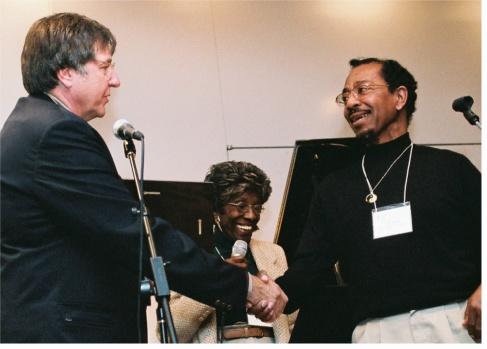Jazz Alliance History
1999: NEJA Established; Brent Banulis First President
Many individuals contributed to the development of the New England Jazz Hall of Fame, but the person who got it all started was a resident of East Boston, Brent Banulis. Brent’s vision and energy brought people together to form the New England Jazz Alliance (NEJA) in 1999. As NEJA’s first president, he led the drive to create the Hall of Fame in 2001. But Banulis’s commitment to jazz took root even before that.
Banulis, originally from Bristol, Connecticut, caught the music bug early, starting with the alto sax in grade school. He was the saxophone-playing leader of his high school dance band. While studying journalism at Notre Dame University, he played tenor in the jazz band and helped organize the Michiana Friends of Jazz, a volunteer group of enthusiasts. After graduation, he formed Sounds Unlimited, an 18-piece big band playing the music of the acclaimed arranger Johnny Richards.
In 1969, Banulis moved to Boston to study at Berklee with Charlie Mariano. He traveled widely in the 1970s, living for a time in far-flung locales like Mauritius and South Africa. In 1982, Banulis and his wife Carolyn settled in East Boston, and he went to work as an editor at the Boston Globe.

Brent Banulis, Mae Arnette and Paul Brown
during the 2003 Unsung Hero Award Ceremony
Banulis traces his deep interest in New England jazz to an encounter with the late trumpeter Malcolm “Shorty” Jarvis. Banulis told the Boston Herald in 2002: “I heard Malcolm Jarvis give a talk on Boston jazz history. He was a frustrated man standing up there saying this is such a great story to tell and no one’s told it. I took it to heart. I wanted to get Boston to celebrate its jazz history the way cities like Kansas City and New York do.”
Banulis dreamed big. He wanted to create a jazz hall of fame, housed in a permanent facility which included performance and teaching space. He thought the ideal location would be on the emerging East Boston waterfront. To promote the idea, he published the Jazz on the Waterfront newsletter in 1997-98. But there was neither adequate funding nor suitable space available for his project.
When his efforts failed to take hold in Boston, Banulis next considered a portable hall of fame—a traveling exhibit accompanied by live presentations. He also broadened his scope, envisioning an exhibit that could reach any point in New England. With this in mind, Banulis gathered allies, and founded the New England Jazz Alliance in 1999. Its goals were to establish the hall of fame, and use it to bring the music to a new generation of listeners.
Banulis presided over NEJA during its first six years, a vital time that witnessed the creation of the hall of fame and the formation of the college of voters that legitimized it. The New England Jazz Hall of Fame came into existence on December 17, 2001, with the naming of the first ten inductees. The traveling exhibit made its debut in April 2002. NEJA established its Unsung Hero award in 2003 to recognize those who worked away from the limelight to promote the music and expand its audience. A second hall of fame election cycle added five new members in April 2004.
After playing a major role in all of these activities, Banulis decided to step down as NEJA’s president. He completed his term in May 2005.
2005: Ron Gill Elected NEJA President
The NEJA Board of Directors opened a new chapter in the organization’s history at its annual meeting in Worcester on May 21, 2005. By unanimous vote, the Board elected Ron Gill NEJA’s new president, succeeding Brent Banulis in that office.
How does he view his new job? Gill sees the president involved in numerous activities—education and communication being two important ones. But the first role the NEJA membership may see Gill fill is that of organizer. "I intend to be visible, talking about jazz and educating people about it. But education takes many forms, and in the coming months I will call on all the members to join me in making NEJA a known entity in the jazz community. Our slogan will be, "I Am a Jazz Advocate." It will be more than a slogan, though. It will also be a real effort to make each member an important voice for jazz."
If anyone has credentials for this position, it is Ron Gill. He has deep roots in the Boston community. Except for a hitch in the U.S. Army, Ron has lived in the Boston area since 1946. Hes been singing since his early teens in the 1940s. Hes hosted the "Jazz Gallery" on WGBH radio since 1988. And he has "relevant job experience" earned through his tenure as activist in, and later president of, Boston’s Jazz Coalition in the early 1980s.
Gill established himself as a local singer/performer in his teens, singing at local dance halls, private parties and when he was finally old enough, in local night spots. He performed and recorded with the Calypso Rhythm Boys, headlined by "The Charmer" for Tico and Monogram Records.
In the mid-fifties, Gill joined the U.S. Army. When he returned to Boston, he started a family, and gradually rejoined the local music scene, singing in clubs and at venues like Elma Lewiss Playhouse in the Park in the sixties.
In 1968 he formed a group with his teenage friend and accompanist, Manny Williams, and Reid Jorgensen on drums. This is the nucleus of a group that still plays together today.
Gill toured New England in 1974 with the Duke Ellington Orchestra, led by Mercer Ellington. But more involvement with Ellingtonia lay ahead. "In 1977, Ran Blake asked me to sing "Day Dream" in concert at Jordan Hall. After that performance I was hooked on the music of Billy Strayhorn, and it took twenty years for me to complete my investigation of his work and perform it." Concert appearances in 1997 led to the release of his CD, Ron Gill Sings the Songs of Billy Strayhorn, in 1998. Other gigs, as both performer and producer, have continued to the present.

Ron Gill, NEJA President 2005-09
Gill points to his Jazz Coalition days as his real NEJA training ground. He learned to gain the support of major institutions, like the Mayor's Office Of Cultural Affairs, and to develop contacts with the local media. Having this network in place helped the Coalition’s signature activities—Boston Jazz Week, the Jazz All Night concerts—succeed. Gill is convinced that building and cultivating such a network across New England will be a key part of the Jazz Advocate campaign. Says Gill: "Jazz advocacy can’t succeed without a solid foundation. I’m looking forward to building on the strong base we already have in place."
2009: Ed Bride Assumes Presidency
As part of its May 15, 2009 meeting, the New England Jazz Alliance Board of Directors elected as its new officers Edward Bride, President; Ted Belastock, Vice President; and Barbara Bishop, Secretary/Treasurer.
Ed Bride, who resides in Pittsfield, MA, succeeds Ron Gill as NEJA President. Gill served admirably in this capacity for the past three years and the NEJA Board of Directors thanks him for his service.
Bride has been a jazz aficionado since his teens, and has for years promoted both well-known and obscure big bands as well as other mainstream groups. He is a member of several non-profit boards that advocate for jazz education including American Jazz Venues, Berkshire Jazz, Inc., and the New England Jazz Ensemble. Bride is the founder and chairman of the Pittsfield City Jazz Festival and is a founding member of the NEJA Board, having previously served as its Secretary.
Vice President Ted Belastock, of Boston, was one of the organizers of the Brockton (MA) Jazz Festival, and the publisher of Quarter Notes magazine. Longtime jazz advocate Barbara Bishop, from Winthrop, MA was one of the organizers of the Oceanside Jazz Festival in that city. Bishop also serves as the unofficial NEJA videographer.
